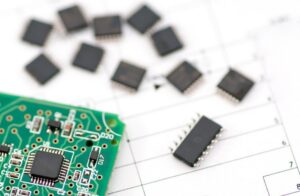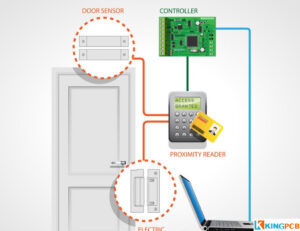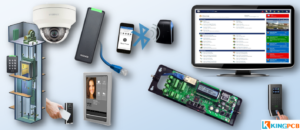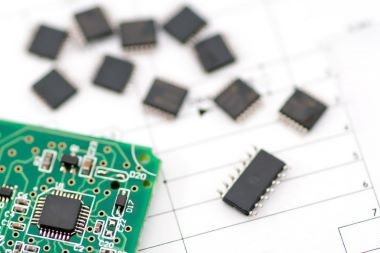
Access control systems play a critical role in maintaining the security of buildings, offices, and various other restricted areas. In such systems, access control printed circuit board (PCB) assemblies are the primary component that manages and controls the access of individuals. These PCB assemblies need to be designed and assembled with utmost care to ensure their proper functioning and reliability.
In this blog, we will discuss some essential access control PCB assembly guidelines which need to follow to ensure an efficient and secure access control system.
What is access control PCB?
Access control PCB (Printed Circuit Board) refers to a type of printed circuit board that is specifically designed to control access to a particular system or device. This type of PCB is commonly used in security systems, such as door entry systems, key card readers, and other access control systems.
It typically includes a range of components, including microprocessors, memory chips, sensors, and other electronic components that allow the PCB to control and monitor access to a particular system or device.
What about the characteristics about access control PCB?
- High reliability: It must be highly reliable to ensure that the access control system operates consistently and securely.
- Security features: To prevent unauthorized access to the system, it should include built-in security features, such as encryption and authentication.
- Customizability: This may include integrating custom components, features, or communication protocols to meet the unique needs of the system.
- Multilayer design: Use multilayer PCB design to enable the routing of complex circuits and signals, and to optimize the use of available space on the PCB.
- Vias: Buried vias or blind vias can enable the routing of signals and power between different layers of the PCB.
- Automotive-grade components: Use of automotive-grade components to ensure the reliability and durability of the system. They can withstand the harsh conditions of automotive applications.
Generally, access control PCBs play a critical role in ensuring the security and integrity of various systems and devices, and their design and assembly must be carefully managed to ensure optimal performance and reliability.
Design the access control PCB with Proper Layout and Routing
The design of the access control PCB should be done in such a way that it supports proper signal routing, power distribution, and heat dissipation. And the layout should be optimized to minimize the size of the board while ensuring proper clearance and creepage distances. A well-designed PCB layout and routing can help reduce the noise, electromagnetic interference, and crosstalk. It can affect the performance of the access control system.
Use High-Quality PCB Materials
The quality of the PCB material used in the access control PCB assembly. It is crucial to ensure the reliability and longevity of the system. Choose high-quality PCB material with good thermal conductivity, low dielectric loss, and high electrical conductivity. It is also essential to ensure that the PCB material meets the required safety and environmental standards.
Ensure Proper Soldering Techniques
The soldering process is one of the critical steps in the access control PCB assembly. Proper soldering techniques should follow to ensure good solder joints, which are essential for the proper functioning of the system. Soldering temperature, time, and type of solder for use should carefully select to avoid any thermal stress on the PCB and components.
Optimize Component Placement
The placement of components on the access control PCB should be optimized to minimize the size of the board, reduce the signal path length, and improve the thermal management of the system. Proper placement of components can help avoid any signal interference or crosstalk, which can affect the performance of the system.
Use ESD Protection Measures
Electrostatic discharge (ESD) can damage the access control PCB and its components, leading to system failure. Therefore, should take proper ESD protection measures. Such as handle ESD-sensitive components with proper care, and follow proper grounding techniques during the assembly process.
Follow IPC Standards
The International Association of Electronics Industry (IPC) standards defines the guidelines for designing and assembling PCBs. It is essential to follow these standards to ensure the stability of the access control PCB assembly. IPC standards provide guidelines for the design, materials, assembly process, and inspection of PCBs. It can help ensure the proper functioning of the access control system.
Use Automated Assembly Processes
Automated assembly processes can help improve the durability of the access control PCB assembly. It can ensure precise component placement, accurate soldering, and proper testing of the system. Also help reduce the cost of production and improve the efficiency of the assembly process.
Perform Proper Testing and Inspection
Proper testing and inspection of the access control PCB assembly are crucial to ensure the robustness and performance of the system. Functional testing shall take place to ensure that the system meets the required specifications. Visual inspection and automated optical inspection (AOI) should be performed to detect any defects in the assembly process.

What are some of the factors to consider in choosing access control PCB board?
When choosing an access control PCB board, there are several factors that you should consider to ensure that the board meets the specific requirements of your access control system. These factors include:
Size and form factor
The size and form factor of the PCB should be carefully considered to ensure that it can be easily integrated into the access control system. Designs to fit into the available space and should have the necessary mounting holes and connectors to connect to other components.
Power requirements
When selecting the access control PCB, it should consider the power requirements of the access control system. Handle the required voltage and current levels of the system, and it should be able to deliver power to other components as needed.
Connectivity options
The access control PCB should have the necessary connectivity options to communicate with other components in the system, such as sensors, keypads, and controllers. The PCB should have the necessary ports and connectors to support the required communication protocols, such as Ethernet, RS485, or CAN.
Security features
Access control systems require high levels of security to prevent unauthorized access. Therefore, to ensure the integrity and security of the system. The access control PCB should have built-in security features, such as encryption and authentication,
Environmental factors
The access control system allows installation in harsh environments, such as outdoor or industrial environments. Therefore, the access control PCB should design to withstand the specific environmental conditions. For example, temperature, humidity, and vibration that it will expose to.
Customizability
Some access control systems may require custom-designed PCBs to meet specific requirements. Therefore, the access control PCB should be customizable to allow for the integration of custom components or features as needed.
Overall, choosing the right access control PCB is critical to the performance and reliability of the access control system. By carefully considering these factors, you can ensure that the PCB meets the specific requirements of the system and provides optimal performance and security.
Modern applications in the access control industry

The access control industry is constantly evolving to meet the needs of modern security systems. Advances in technology have enabled the development of new applications in the access control industry, including:
- Biometric access control
It uses unique biological characteristics, such as fingerprints, iris patterns, or facial recognition, to grant access to a system or device. Biometric access control provides a high level of security and eliminates the need for physical keys or access cards.
- Mobile access control
It allows users to access a system or device using their smartphones or mobile devices. This eliminates the need for physical access cards and provides a convenient and secure way to manage access control.
- Cloud-based access control
It allows remote management and control of the access control system using cloud-based software. This provides greater flexibility and scalability for access control systems, as well as easier management and monitoring of the system.
- Wireless access control
This technologies eliminates the need for physical wiring between components, allowing for more flexible and scalable access control systems. Some of the technologies available are Bluetooth, Wi-Fi, or RFID.
- Integrated access control
The integrated access control systems combine multiple security systems. Such as access control, CCTV, and alarm systems, into a single, integrated system. This provides a comprehensive and cohesive approach to security management.
- IoT-based access control
IoT-based access control uses Internet of Things (IoT) technology to connect access control systems to other devices and systems. This allows for greater automation and integration of access control systems with other building management systems, such as lighting and HVAC.
To sum up, these modern applications in the access control industry provide greater flexibility, convenience, and security for access control systems. By leveraging these technologies, businesses and organizations can improve their security posture and better manage access to their systems and facilities.
Conclusion
Access control PCB assembly is a critical process that requires great care to complete to ensure the reliability and performance of the access control system.
Working with a reliable PCB supplier with experience in access control PCB assembly can help ensure that the PCBs meet the required safety and environmental standards. Contact us now to get a quick quotation for your projects!




